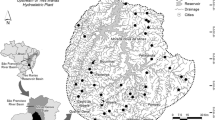Abstract
The gathering of quantitative information on aquatic macrophyte communities in artificial drainage and navigation channels presents a number of methodological and analytical problems. These include: subjectivity of plant abundance estimation, the conflict between standardisation and adaptation of methods to specific purposes, and the concepts of randomness and homogeneity in linear surveying. As a result, much of the currently available information is highly subjective and difficult to use in any comparative way, either temporally or spatially. More standardised procedures should be developed which minimise these shortcomings and permit later re-use of data in comparative studies.
Similar content being viewed by others
References
Alcock, M. R. & M. A. Palmer, 1985. A standard method for the survey of ditch vegetation. Chief Scientist's Team Note 37, Nature Conservancy Council, Peterborough, England.
Bradbury, I. K. & J. Grace, 1983. Primary production in wetlands and mires: swamp, bog, fen and moor. Gore, A. J. P. (ed.), Elsevier, Amsterdam.
Brummer, J. E., J. T. Nichols, K. Engel, & K. M. Eskridge, 1994. Efficiency of different quadrat sizes and shapes for sampling standing crop. J. Range Mgmt 47: 84–89.
Catchpole, W. R. & C. J. Wheeler, 1992. Estimating plant biomass: a review of techniques. Aust. J. Ecol. 17: 121–131.
ECN (in press) Monitoring aquatic macrophytes within the ECN program, Environmental Change Network. A project based at The Institute of Terrestrial Ecology, Merlewood England.
Hegarty, C. A. & A. Cooper, 1994. Regional variation of hedge structure and composition in Northern Ireland in relation to management. Proc. r. Irish Acad. 94B: 223–236.
Jongman, R. H. G., C. J. F. Ter Braak & O. F. R. Van Tongeren, (eds), 1995. Data Analysis in Community and Landscape Ecology. 2nd edn. Cambridge University Press, Cambridge.
Kendall, S., 1987. A Botanical Survey of The Leven Canal: a report produced for the Nature Conservancy Council, North Eastern Region, Peterborough, England.
Kershaw, K. A. & J. H. H. Loony, 1985. Quantitative and dynamic plant ecology. 3rd edn. Edward Arnold. London.
Li, H. & J. F. Reynolds, 1994. A simulation experiment to quantify spatial heterogeneity in categorical maps. Ecology 75: 2446–2453.
Murphy, K. J & J.W. Eaton 1983. Effects of pleasure-boat traffic on macrophyte growth in canals, J. appl. Ecol. 20: 713–729.
Rapson, G. L., K. Thompson & J. D. Hodgson, 1997. The humped relationship between species richness and biomass - testing its sensitivity to quadrat size. J. Ecol. 85: 99–100.
Spencer, D. F. & G. G. Ksander, 1993. Spatial pattern analysis for underground propagules of Potamogeton gramineus L. in two Northern California irrigation canals. J. Freshwat. Ecol. 8: 297–333.
Underwood, A. J., 1994. Spatial and temporal problems with monitoring. In Calow, P. & G. E. Petts (eds), The Rivers Handbook, Vol. 2. Blackwell Scientific Publications, Oxford: 101–123.
Author information
Authors and Affiliations
Rights and permissions
About this article
Cite this article
Hatcher, D., Eaton, J., Gibson, M. et al. Methodologies for surveying plant communities in artificial channels . Hydrobiologia 415, 87–91 (1999). https://doi.org/10.1023/A:1003881517387
Issue Date:
DOI: https://doi.org/10.1023/A:1003881517387




